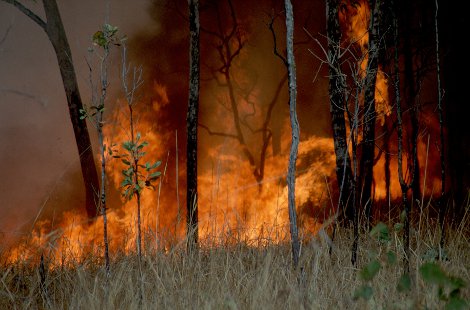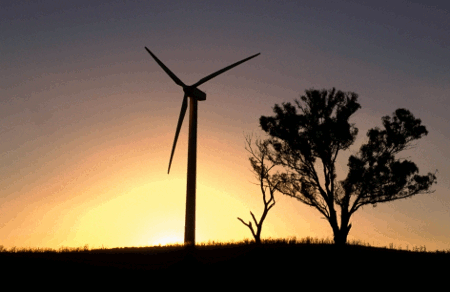
|
Published: 5 September 2011
Climate change bulletin: current research highlights
Fire is one of nature’s primary carbon-cycling mechanisms. Under a warming climate, fire frequency and severity will likely increase, according to CSIRO researcher Dr Melita Keywood.
Dr Keywood is lead author of a recent international atmospheric study reviewing global impacts – ‘Fire in the air: biomass burning impacts in a changing climate’, just published in the journal Critical Reviews in Environmental Science and Technology.
Fires require fuel to burn. The type, quantity and quality of fuel (vegetation) is influenced by climate. Periods of high rainfall or high carbon dioxide loadings may increase vegetation growth, adding to fuel loads in future fire seasons.
Reduced water availability associated with drought may result in drier vegetation, which is likely to burn more readily and with higher intensity. Higher temperatures and other extreme weather may also lengthen fire seasons, and increase the likelihood of ignition and longer burning periods. In turn, fires influence climate by emitting aerosols and greenhouse gases, and by affecting the ability of vegetation to subsequently sequester carbon.
Dr Keywood points to a wildfire that burned over 400 square miles of Alaska tundra in the scorching summer of 2007. The fire poured as much carbon into the atmosphere as the entire Arctic normally absorbs each year, according to a study recently published in the scientific journal Nature. 1
What will 4ºC of global warming look like?
At the recent Four Degrees climate change conference in Melbourne, CSIRO’s Dr Penny Whetton discussed the impacts on Australia of a 4ºC increase in average annual temperatures. The impacts include major reductions in annual rainfall in south east Australia, marked increases in evaporation nationwide and reduced snow cover in alpine regions.
Dr Whetton said that compared with annual average temperatures recorded in 1850, a 4ºC warming might occur by the end of this century if greenhouse gas emissions stay high.
‘Rapid global warming of 4ºC would be unlike anything experienced before by modern human societies – presenting us with huge challenges in terms of our ability to adapt,’ Dr Whetton said.
According to a review of recent climate models by CSIRO and Melbourne University, Australian climate changes at 4ºC or more of global warming might include:
-
temperature increases of about 3–5°C in coastal areas and 4–6°C in inland areas
-
likely declines of annual rainfall in southern Australia, particularly in winter, of up to about 50 per cent, but uncertain rainfall changes in other regions
-
marked increases of potential evaporation of about 5–20 per cent
-
more droughts in southern Australia
-
snow cover duration falling to zero in most alpine regions.
CSIRO produced national climate projections in 1990, 1992, 1996 and 2001, and jointly with the Bureau of Meteorology in 2007. The next set of national climate projections is planned for release in 2014, representing a significant climate science milestone timed to follow the next global assessment by the Intergovernmental Panel on Climate Change.
‘In three years, Australians will have the latest climate projections for the 21st century for a range of factors, including sea levels, seasonal-average temperatures [and] rainfall, as well as extreme weather events such as heatwaves, fires, droughts, floods and cyclones,’ Dr Whetton said.
More accurate estimate of forest sequestration
The world’s established forests remove 2.4 billion tonnes of carbon per year from the atmosphere – equivalent to one-third of current annual global fossil fuel emissions – according to new research published in the journal Science. 2
This is the first time that volumes of carbon dioxide absorbed from the atmosphere by tropical, temperate and boreal forests have been so clearly identified.

|
|
Scientists are getting a more accurate idea of how much carbon the world’s forests – like this one in NSW – remove from the atmosphere.
Credit: Joe Gough/istockphoto
|
‘This is really a timely breakthrough with which we can now clearly demonstrate how forests and changes in landscape such as wildfire or forest regrowth impact the removal or release of atmospheric carbon dioxide,’ says CSIRO’s Dr Pep Canadell, co-author of the paper.
Dr Canadell, who is also the Executive Director of the Global Carbon Project, said the international research team combined data from forest inventories, models and satellites to construct a profile of forests as major regulators of atmospheric carbon dioxide.
Fewer rain storms across southern Australia
Decreasing autumn and winter rainfall over southern Australia has been attributed to a 50-year decrease in the average intensity of storms – a trend forecast to continue for another 50 years.
CSIRO climate scientist, Dr Jorgen Frederiksen, says these changes are due to reductions in the strength of the mid-latitude jet stream and changes in atmospheric temperatures. The jet stream comprises fast-moving westerly winds in the upper atmosphere.
‘The drop in winter and autumn rainfall observed across southern Australia is due to a large downturn in the intensity of storm formations over at least the last three decades compared with the previous three decades, and these effects have become more pronounced with time,’ says Dr Frederiksen.
Dr Frederiksen’s comments were based on recently published CSIRO and Bureau of Meteorology research. 3 This centres on the changes in southern Australian winter rainfall linked to atmospheric circulation changes that are directly associated with storm formation; particularly rain?bearing lows and frontal systems crossing southern Australia.
The most important circulation feature associated with winter storm formation is the strength of the sub-tropical jet stream. For example, winter storms give south-west Western Australia much of its rain. Between the 20-year periods 1949–1968 and 1975–1994, south-west Western Australia rainfall reduced by 20 per cent. In south-east Australia, there were reductions of 10 per cent.
1 http://www.nature.com/nature/journal/v475/n7357/full/nature10283.html
2 Pan Y et al (2011) A Large and Persistent Carbon Sink in the World’s Forests, Science, 333 no. 6045 pp. 988-993 DOI: 10.1126/science.1201609
3 Frederikson C S et al. (2011) Changes and Projections in Australian Winter Rainfall and Circulation: Anthropogenic Forcing and Internal Variability. International Journal of Climate Change: Impacts and Responses, Volume 2, Issue 3, pp.143-162.




